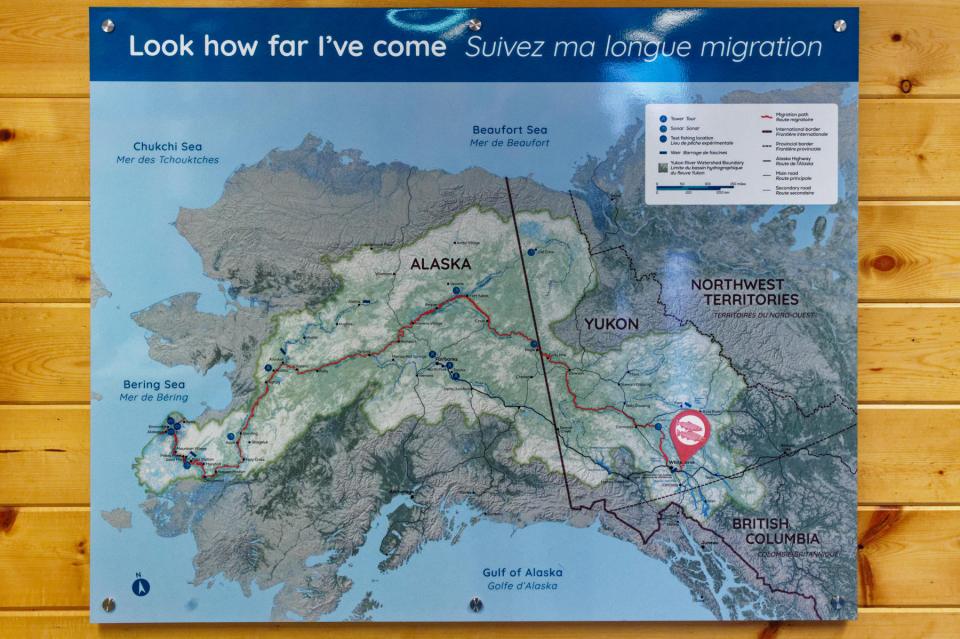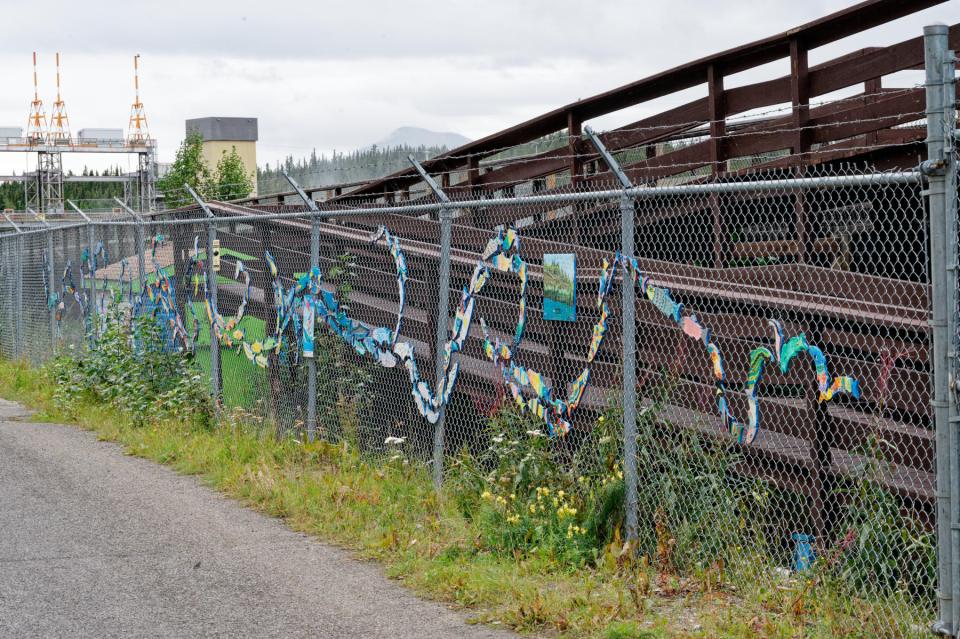Tuesday and Wednesday 30 and 31 August 2022 – Utter Monster Post Alert! Get yourself a large drink before attempting this one!
Part One of our Canadian odyssey (rugged-north-west-and-wildlife) ended as we arrived in Vancouver on Monday with the prospect of taking it easy and drawing breath after three full-on weeks of Relentless Tourism. So, how did we spend our first day of taking it easy? Of course – an 11-mile walk. With lunch. Obviously.
Actually, one thing first. Having had a late breakfast (our specialist subject if at all possible) we were psyching ourselves up for going out when we were startled by a loud blast of four chords. At first, since we’re by the cruise ship terminal, we thought it was a ship leaving, but eventually rumbled that this is something that happens at midday every day in Vancouver – the Heritage Horns. We had actually heard them on our first visit, but because we were by the Gastown Steam Clock, I had thought it was part of that performance. You can hear the chords as the first notes on the video I recorded at the time:
For our walk, Jane mapped out a route which would see us walking around some or all of False Creek and visiting Granville Island, which are south of downtown Vancouver. Here’s a map of the first 8 miles to give you an idea of the geography:

To get to Granville Island, you can walk down, erm, Granville Street, along which can be found several interesting buildings which hark back to the early 20th century.



We also noticed, in the pavement, some stars.

This turned out to be the British Columbia Entertainment Hall of Fame. Immediately we started to try to think of famous Canadian entertainers, roughly on a par with famous Belgians. Quick! Name some!


Now I can say I have photos of Michael Bublé and Bryan Adams.
We wondered why Granville Street was the home of this Hall of Fame and eventually spotted a theatre or two, and the Orpheum

originally a vaudeville house and now home to the Vancouver Symphony Orchestra. I hope today’s audience can spot the difference.
We passed an architecturally fascinating building which revealed a secret that I’ll share with you later.
All of a sudden, we found ourselves committed to walking across the water beside a 4-lane highway, which wasn’t the original plan; we’d fondly believed we could find a way directly on to Granville Island, but now were several hundred feet above it with no way down. We did pass one interesting sight whilst on the bridge, though. All together now, to the tune of “What Shall We Do With The Drunken Sailor?”:
Again, more on this later.
We (Jane) eventually found a way off the bridge and on to the southern shore of False Creek, hence bypassing Granville Island completely. But since we had a Nice Lunch planned on the island we knew that we’d be back, so we started off on our trek round the eastern edge of False Creek.
Which is lovely, especially on the glorious sunny day we had. It offers great views of the city



and look! there’s that fascinating piece of architecture I mentioned earlier. I shall reveal later the secret of why it doesn’t tip over.
The walk around False Creek is very pleasant; there’s a pedestrian trail and a separate and segregated cycle trail (along which the traffic is occasionally quite dense). As well as great views of the city, it offers

a formally Protected View between buildings to the Two Lions – peaks which give their name to the Lions Gate Bridge north of Stanley Park;

this cute bridge;


some interesting artworks;

and the Science Park. This takes you to the eastern end of False Creek. The route back towards Granville Island along the northern shore is equally pleasant, with many diversion on the way.

The “Time Top”, an installation by Jerry Pethick, which is enlivened by a shoreline cartoon engraved in kerbstones by William Ritt and Clarence Gray


“The Proud Youth“, a new installation from 2021, part of the Vancouver Biennale public art festival;

an installation which presumably moves as the tide changes;

and, bizarrely, under the Granville Street Bridge, a chandelier – again, a newish public art installation from 2019.
So, by this stage we had completed the circuit round the eastern bit of False Creek, but we were now separated from Granville Island – and lunch – by the creek itself. Fortunately, there’s a ferry service to take one across the gap.
 Aquabus (Latin) – to, for, by with or from water.
Aquabus (Latin) – to, for, by with or from water.
Granville Island is most noted for its Public Market, which is a wonder – sort of like Borough Market (for those who know it), but more so.



The area outside is also a very nice and slightly quirky place to be,


and you get a great view of the Burrard Street Bridge.

There are buskers and entertainers Doing Their Thangs – this chap was Quinn – ex-Cirque du Soleil and as well as being very skillful (spot the knife coming in from the right for him to catch) was very entertaining.


We walked around the perimeter of Granville Island to get back to the ferry point. It was very pleasant in the sunshine, with a kids’ splashpark and play area and some nice waterside dwellings.


There were some shenanigans between a “pirate galleon” (note, though the modern outboard engine)

and a poor sap in a small boat, obviously set up to be a target

and then left to bail his dinghy out as the galleon buggered off.

We passed the Ugly Silos again

and discovered that the faces are, you guessed it, a quirky art installation, this one a spray-painted mural by twin brothers Gustavo and Otavio Pandolfo. Even the gates and fences of this place (a cement works) were decorated quirkily.

Nearby was a pavilion of some sort. We never established what it was for, but it has some great carvings on the pillars

and there’s another grizzly bear artwork nearby.

We caught the ferry back to the northern shore across a short but busy stretch of water

and walked back to the hotel along pavements occasionally decorated with leaf imprints

passing the final photo of the day, another scene with interesting light caused by low sun and reflections.

Oh – I must reveal the architectural secret of that remarkable building which appears to be about to fall over. Here it is, seen from the city side.

What a brilliant design, eh?
That was it for the day, and we had a relatively early night, disturbed only by a strange pulsing buzzing noise which seemed to be coming from outside the hotel. I went out to check, and there was a huge thumping and rumbling coming from the port as a large container ship was being dealt with; the low frequency and high decibel count of the noise meant that the sound laughed at our double glazing as it passed through into our hotel room. Fortunately it didn’t ruin our sleep too badly.
We had resolved to make the middle day of our time here a real time to relax. No, really relax, and save some energy for tomorrow. So, what did we end up doing? Relaxing in the room? A spa session? Gym workout? Erm – going for a walk. Only a little one, honest. We wanted to see the Marine Building,

which is very close to the hotel. Completed in 1930, at the time of its opening it was the city’s tallest skyscraper – and the tallest in the British Empire – and it is listed among the best Art Deco buildings in the world. Art Deco is catnip to Jane, so off we went.
My word, what a place!
The entrance is a bit of a clue.

and then you step inside….





It’s a treat for the eyes, it really is. Obvs, we have many more photos, but I hope that gives you the general idea.
We did a small but important piece of shopping whilst we were out (see later) and on the way back saw the cathedral that we’d been unable to get to in our earlier visit to Vancouver. (We’d been to the Holy Rosary Church, but not Christ Church Cathedral). But there it was, dwarfed by the tower blocks around it,

so in we went. It’s a delightful interior – calm and quiet, even though the city’s buzz and bustle is only yards away.

It has a fantastic roof

and round the back there’s a cloister garden

upon to which backs the Bill Reid Art Gallery.

As well as this, as we went to do that shopping and walk back to the hotel, Vancouver had, of course, more street art to show:


and other imposing buildings, too.


The small but important piece of shopping?

Now we can relax! See you tomorrow?



























































 and – my favourite – a lynx. I wouldn’t have spotted it, but Jane did and between us we managed to get a very satisfactory image even though it was quite distant. My mobile phone did a great job, here.
and – my favourite – a lynx. I wouldn’t have spotted it, but Jane did and between us we managed to get a very satisfactory image even though it was quite distant. My mobile phone did a great job, here.
